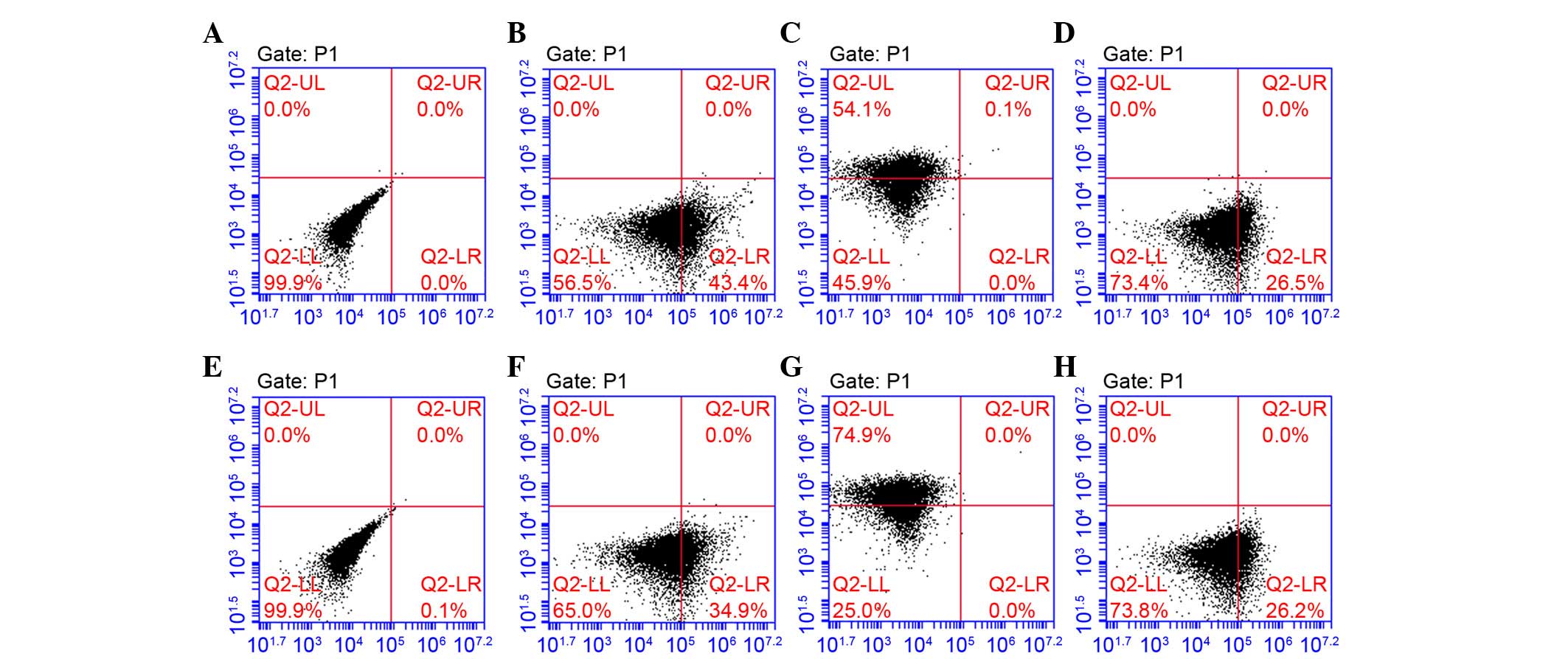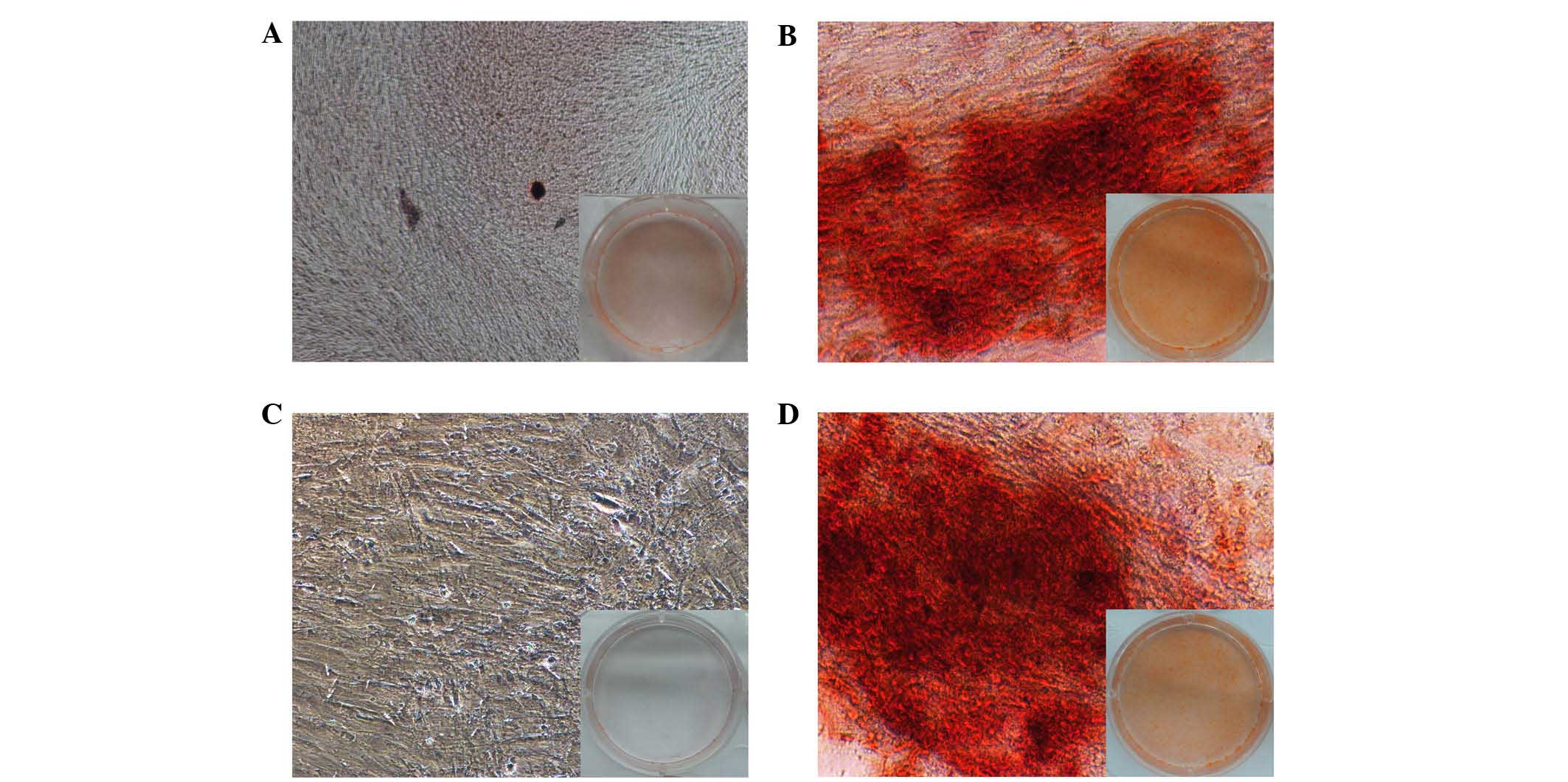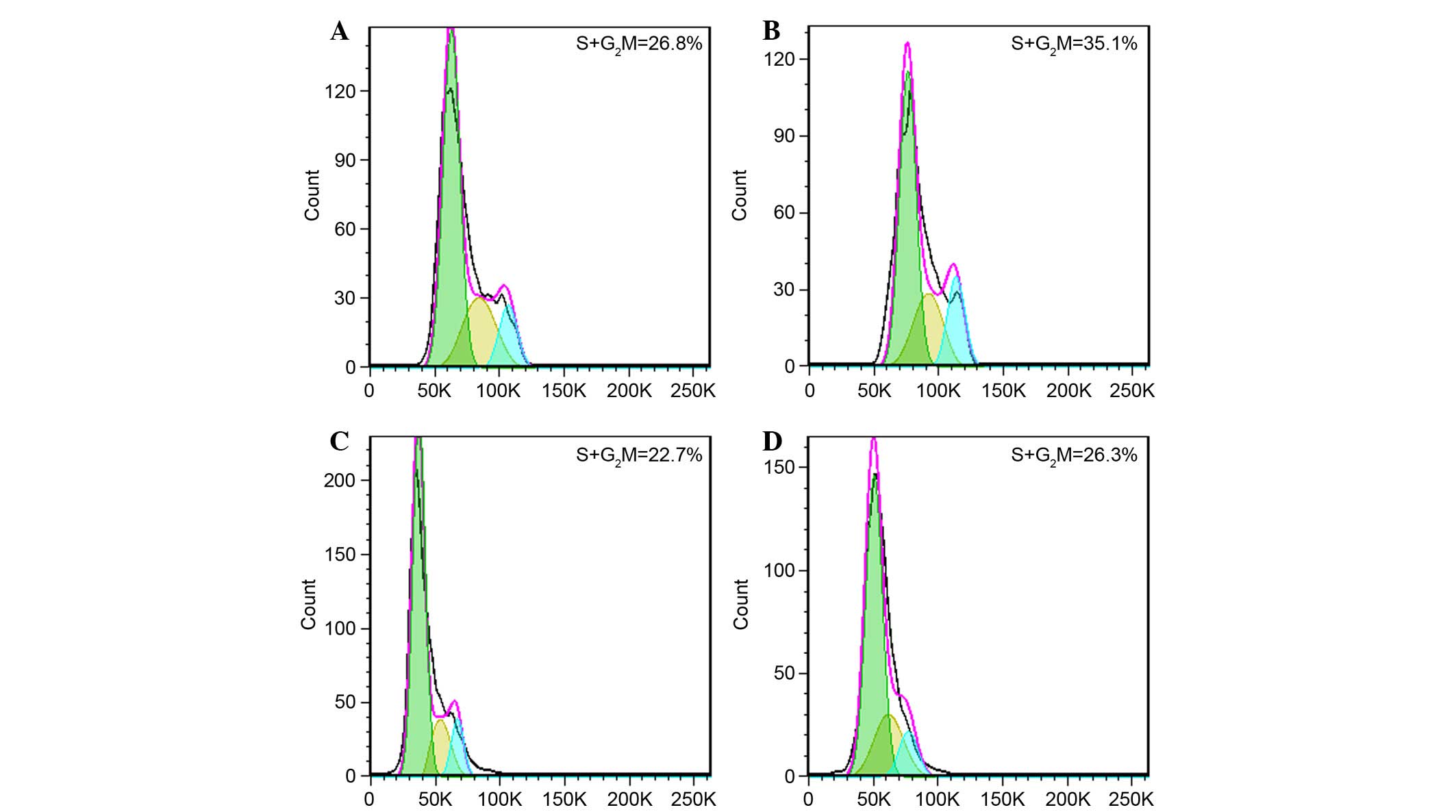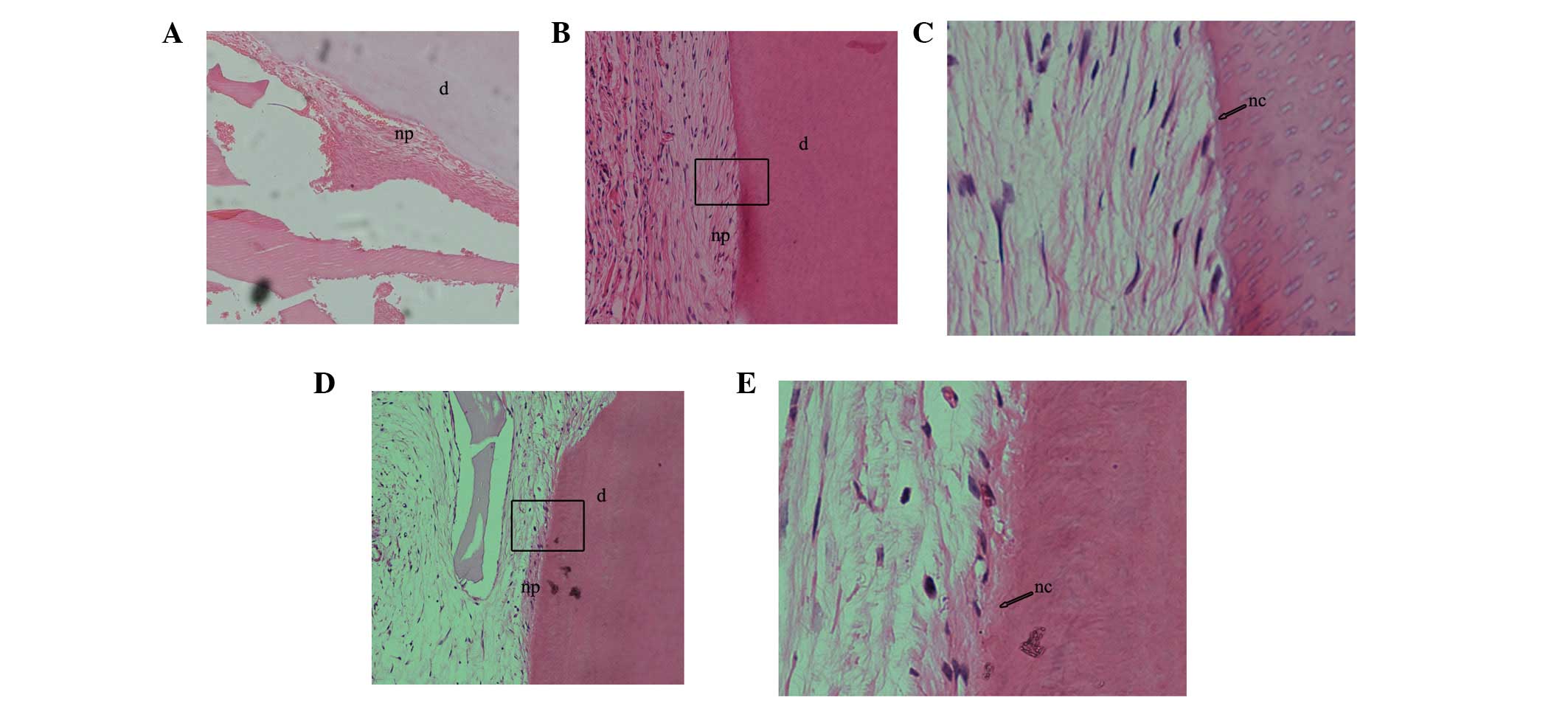|
1
|
Chen FM, Zhang J, Zhang M, An Y, Chen F
and Wu ZF: A review on endogenous regenerative technology in
periodontal regenerative medicine. Biomaterials. 31:7892–7927.
2010. View Article : Google Scholar : PubMed/NCBI
|
|
2
|
Chen FM and Jin Y: Periodontal tissue
engineering and regeneration: Current approaches and expanding
opportunities. Tissue Eng Part B Rev. 16:219–255. 2010. View Article : Google Scholar
|
|
3
|
Seo BM, Miura M, Gronthos S, Bartold PM,
Batouli S, Brahim J, Young M, Robey PG, Wang CY and Shi S:
Investigation of multi-potent postnatal stem cells from human
periodontal ligament. Lancet. 364:149–155. 2004. View Article : Google Scholar : PubMed/NCBI
|
|
4
|
Naveau A, Reinald N, Fournier B, Durand E,
Lafont A, Coulomb B and Gogly B: Gingival fibroblasts inhibit MMP-1
and MMP-3 activities in an ex-vivo artery model. Connect Tissue
Res. 48:300–308. 2007. View Article : Google Scholar : PubMed/NCBI
|
|
5
|
Zhang Q, Shi S, Liu Y, Uyanne J, Shi Y,
Shi S and Le AD: Mesenchymal stem cells derived from human gingiva
are capable of immunomodulatory functions and ameliorate
inflammation-related tissue destruction in experimental colitis. J
Immunol. 183:7787–7798. 2009. View Article : Google Scholar : PubMed/NCBI
|
|
6
|
Mitrano TI, Grob MS, Carrión F,
Nova-Lamperti E, Luz PA, Fierro FS, Quintero A, Chaparro A and Sanz
A: Culture and Characterization of mesenchymal stem cells from
human gingival tissue. J Periodontol. 81:917–925. 2010. View Article : Google Scholar : PubMed/NCBI
|
|
7
|
Wang F, Yu M, Yan X, Wen Y, Zeng Q, Yue W,
Yang P and Pei X: Gingival-derived mesenchymal stem cell-mediated
therapeutic for bone tissue regeneration. Stem Cells Dev.
20:2093–2102. 2011. View Article : Google Scholar : PubMed/NCBI
|
|
8
|
Zhang QZ, Su WR, Shi SH, Wilder-Smith P,
Xiang AP, Wong A, Nguyen AL, Kwon CW and Le AD: Human
gingiva-derived mesenchymal stem cells elicit polarization of M2
macrophages and enhance cutaneous wound healing. Stem Cells.
28:1856–1868. 2010. View
Article : Google Scholar : PubMed/NCBI
|
|
9
|
Kushida A, Yamato M, Konno C, Kikuchi A,
Sakurai Y and Okano T: Decrease in culture temperature releases
monolayer endothelial cell sheets together with deposited
fibronectin matrix from temperature-responsive culture surfaces. J
Biomed Mater Res. 45:355–362. 1999. View Article : Google Scholar : PubMed/NCBI
|
|
10
|
Yang J, Yamato M, Kohno C, Nishimoto A,
Sekine H, Fukai F and Okano T: Cell sheet engineering: Recreating
tissues without biodegradable scaffolds. Biomaterials.
26:6415–6422. 2005. View Article : Google Scholar : PubMed/NCBI
|
|
11
|
Hasegawa M, Yamato M, Kikuchi A, Okano T
and Ishikawa I: Human periodontal ligament cell sheets can
regenerate periodontal ligament tissue in an athymic rat model.
Tissue Eng. 11:469–478. 2005. View Article : Google Scholar : PubMed/NCBI
|
|
12
|
Yang Z, Jin F, Zhang X, Ma D, Han C, Huo
N, Wang Y, Zhang Y, Lin Z and Jin Y: Tissue engineering of
cementum/periodontal-ligament complex using a novel
three-dimensional pellet cultivation system for human periodontal
ligament stem cells. Tissue Eng Part C Methods. 15:571–581. 2009.
View Article : Google Scholar : PubMed/NCBI
|
|
13
|
Iwata T, Yamato M, Tsuchioka H, Takagi R,
Mukobata S, Washio K, Okano T and Ishikawa I: Periodontal
regeneration with multi-layered periodontal ligament derived cell
sheets in a canine model. Biomaterials. 30:2716–2723. 2009.
View Article : Google Scholar : PubMed/NCBI
|
|
14
|
Koyanagi M, Brandes RP, Haendeler J,
Zeiher AM and Dimmeler S: Cell-to-cell connection of endothelial
progenitor cells with cardiac myocytes by nanotubes: a novel
mechanism for cell fate changes? Circ Res. 96:1039–1041. 2005.
View Article : Google Scholar : PubMed/NCBI
|
|
15
|
Kikuchi H, Suzuki K, Sakai N and Yamada S:
Odontoblasts induced from mesenchymal cells of murine dental
papillae in three-dimensional cell culture. Cell Tissue Res.
317:173–185. 2004. View Article : Google Scholar : PubMed/NCBI
|
|
16
|
Smith AJ and Lesot H: Induction and
regulation of crown dentinogenesis: Embryonic events as a template
for dental tissue repair? Crit Rev Oral Biol Med. 12:425–437. 2001.
View Article : Google Scholar
|
|
17
|
Yu JH, Shi JN, Deng ZH, Zhuang H, Nie X,
Wang RN and Jin Y: Cell pellets from dental papillae can reexhibit
dental morphogenesis and dentinogenesis. Biochem Biophys Res
Commun. 346:116–124. 2006. View Article : Google Scholar : PubMed/NCBI
|
|
18
|
Harada H, Toyono T, Toyoshima K, Yamasaki
M, Itoh N, Kato S, Sekine K and Ohuchi H: FGF10 maintains stem cell
compartment in developing mouse incisors. Development.
129:1533–1541. 2002.PubMed/NCBI
|
|
19
|
Tummers M and Thesleff I: Root or crown: A
developmental choice orchestrated by the differential regulation of
the epithelial stem cell niche in the tooth of two rodent species.
Development. 130:1049–1057. 2003. View Article : Google Scholar : PubMed/NCBI
|
|
20
|
Harada H and Ohshima H: New perspectives
on tooth development and the dental stem cell niche. Arch Histol
Cytol. 67:1–11. 2004. View Article : Google Scholar : PubMed/NCBI
|
|
21
|
Nakashima M: Bone morphogenetic proteins
in dentin regeneration for potential use in endodontic therapy.
Cytokine Growth Factor Rev. 16:369–376. 2005. View Article : Google Scholar : PubMed/NCBI
|
|
22
|
Ohshima H, Nakasone N, Hashimoto E, Sakai
H, Nakakura-Ohshima K and Harada H: The eternal tooth germ is
formed at the apical end of continuously growing teeth. Arch Oral
Biol. 50:153–157. 2005. View Article : Google Scholar : PubMed/NCBI
|
|
23
|
Livak KJ and Schmittgen TD: Analysis of
relative gene expression data using real-time quantitative PCR and
the 2(-Delta Delta C(T)) method. Methods. 25:402–408. 2001.
View Article : Google Scholar
|
|
24
|
Wittekind D: Traditional staining for
routine diagnostic pathology including the role of tannic acid. 1.
Value and limitations of the hematoxylin-eosin stain. Biotech
Histochem. 78:261–270. 2003. View Article : Google Scholar
|
|
25
|
Thomas HF and Kollar EJ: Differentiation
of odontoblasts in grafted recombinants of murine epithelial root
sheath and dental mesenchyme. Arch Oral Biol. 34:27–35. 1989.
View Article : Google Scholar : PubMed/NCBI
|
|
26
|
Han C, Yang Z, Zhou W, Jin F, Song Y, Wang
Y, Huo N, Chen L, Qian H, Hou R, et al: Periapical follicle stem
cell: A promising candidate for cementum/periodontal ligament
regeneration and bio-root engineering. Stem Cells Dev.
19:1405–1415. 2009. View Article : Google Scholar : PubMed/NCBI
|
|
27
|
Flores MG, Hasegawa M, Yamato M, Takagi R,
Okano T and Ishikawa I: Cementum-periodontal ligament complex
regeneration using the cell sheet technique. J Periodontal Res.
43:364–371. 2008. View Article : Google Scholar : PubMed/NCBI
|
|
28
|
Flores MG, Yashiro R, Washio K, Yamato M,
Okano T and Ishikawa I: Periodontal ligament cell sheet promotes
periodontal regeneration in athymic rats. J Clin Periodontol.
35:1066–1072. 2008. View Article : Google Scholar : PubMed/NCBI
|
|
29
|
Bai Y, Bai Y, Matsuzaka K, Hashimoto S,
Fukuyama T, Wu L, Miwa T, Liu X, Wang X and Inoue T: Cementum- and
periodontal ligament-like tissue formation by dental follicle cell
sheets co-cultured with Hertwig's epithelial root sheath cells.
Bone. 48:1417–1426. 2011. View Article : Google Scholar : PubMed/NCBI
|
|
30
|
Sumita Y, Honda MJ, Ohara T, Tsuchiya S,
Sagara H, Kagami H and Ueda M: Performance of collagen sponge as a
3-D scaffold for tooth-tissue engineering. Biomaterials.
27:3238–3248. 2006. View Article : Google Scholar : PubMed/NCBI
|
|
31
|
Kumar S, Mahendra G and Ponnazhagan S:
Determination of osteoprogenitor-specific promoter activity in
mouse mesenchymal stem cells by recombinant adeno-associated virus
transduction. Biochim Biophys Acta. 1731:95–103. 2005. View Article : Google Scholar : PubMed/NCBI
|
|
32
|
Grzesik WJ and Narayanan AS: Cementum and
periodontal wound healing and regeneration. Crit Rev Oral Biol Med.
13:474–484. 2002. View Article : Google Scholar : PubMed/NCBI
|
|
33
|
Leucht P, Kim JB, Amasha R, James AW,
Girod S and Helms JA: Embryonic origin and hox status determine
progenitor cell fate during adult bone regeneration. Development.
135:2845–285414. 2008. View Article : Google Scholar : PubMed/NCBI
|
|
34
|
Ikeda E, Morita R, Nakao K, Ishida K,
Nakamura T, Takano-Yamamoto T, Ogawa M, Mizuno M, Kasugai S and
Tsuji T: Fully functional bioengineered tooth replacement as an
organ replacement therapy. Proc Natl Acad Sci USA. 106:13475–13480.
2009. View Article : Google Scholar : PubMed/NCBI
|
|
35
|
Kim BS and Mooney DJ: Development of
biocompatible synthetic extracellular matrices for tissue
engineering. Trends Biotechnol. 16:224–230. 1998. View Article : Google Scholar : PubMed/NCBI
|
|
36
|
Polykandriotis E, Arkudas A, Horch RE,
Stürzl M and Kneser U: Autonomously vascularized cellular
constructsin tissue engineering: Opening a new perspective for
biomedical science. J Cell Mol Med. 11:6–2014. 2007. View Article : Google Scholar : PubMed/NCBI
|
















